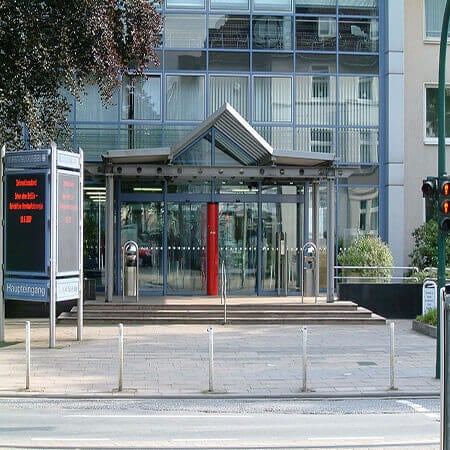Aortic valve insufficiency (AVI) creates the limitations that lead to the blood backflow. If the aortic valve flaps do not fully close (which is the reality with AVI), the backflow is constant. To compensate for the load on the heart, the ventricular muscle walls thicken (hypertrophy), and the ventricular structures increase in volume. Ultimately, despite this compensation, the heart cannot meet the demand for blood supply, which results in failure.
Content
- Overview
- Symptoms
- Options for the treatment of aortic valve insufficiency (AVI)
- Drug treatment of AVI
- Surgery for the treatment of aortic valve insufficiency (AVI)
- Treatment principles
- Life after treatment
- Best hospitals for the treatment of aortic valve insufficiency in Europe
- Prices for the treatment in European hospitals
- Treatment with Booking Health
Overview
When the aortic valve is insufficient, the valve does not close completely, and some amount of blood flows back into the heart, forcing it to work extra to provide sufficient blood supply to the body. As a result, the risk of heart failure increases.
This kind of valvular heart disease develops with age; most people over the age of 80 have some degree of aortic valve insufficiency. Aortic valve insufficiency can also be caused by infection, deposition of calcium salts in the valve, congenital anomaly, and it is often accompanied by aortic valve stenosis.
Symptoms of aortic valve insufficiency usually develop over time. Occasionally, they appear suddenly, without warning, usually due to an infectious lesion or trauma to the valve or artery.
Aortic valve insufficiency (AVI) may be present for years with minimal or no manifestations, except for heart murmurs audible with a stethoscope. At some point, the heart muscle ceases to cope with such a high demand for extra heart functioning, and symptoms of heart failure develop, including shortness of breath, headaches due to high blood pressure, a wheezing sound in the chest, swelling of the legs, and increased risk or frequency of fainting.
If patients have mild forms of insufficiency, they should have regular check-ups with a doctor to monitor the progression of the abnormality. Medications may also be prescribed to control symptoms of heart disease. If the condition worsens, surgery may be needed to repair or replace the valve. In most patients, aortic valve replacement procedures lead to a significant improvement in well-being.
Symptoms
Clinical manifestations of aortic valve insufficiency include:
- Feeling of increased pulsation in the neck, in the head, as well as fast heartbeat.
- Dizziness or lightheadedness.
- Pain in the heart area.
- Shortness of breath.
- Periods of angina pectoris.
Heart pain can occur in patients with severe aortic valve insufficiency long before signs of left ventricular decompensation. The pain is usually localized behind the sternum but often differs in its nature from sensation typical for angina pectoris. Symptoms are not as often associated with physical load or emotional stress as angina attacks in patients with valvular heart disease. The pain often occurs at rest and is pressing or compressive; it usually lasts long enough and is not always stopped by nitroglycerin. Nocturnal angina attacks that may occur in patients with aortic valve insufficiency are accompanied by profuse sweating. Typical angina attacks in patients with aortic valve insufficiency, as a rule, indicate the presence of concomitant coronary heart disease and atherosclerotic narrowing of coronary vessels.
Dyspnea with progressive decrease of left ventricle systolic function turns into orthopnea. Then it is joined by suffocation attacks (cardiac asthma and pulmonary edema). Exercise fatigue rapidly occurs. Understandably, all symptoms associated with cerebral and coronary circulatory function are aggravated when aortic valve insufficiency (AVI) occurs. Finally, in rarer cases, when pulmonary hypertension persists and progresses for a long time, and patients potentially survive left ventricular failure, some signs of blood stasis in the venous channel of the systemic circulation (edema, heaviness in the right subcavity, dyspeptic disorders), associated with a decline in systolic function of the hypertrophied right ventricle may be revealed. However, more often it does not occur and the clinical picture is dominated by the above-mentioned symptoms due to affection of the left heart, peculiarities of the blood filling in the arterial vascular system of the great circle, and signs of blood stasis in the veins of the small circle of circulation.
In terms of medical examination, doctors look for symptoms like pallor of the skin, indicating insufficient perfusion of peripheral organs and tissues.
Options for the treatment of aortic valve insufficiency (AVI)
The main options for the treatment of aortic valve insufficiency (AVI) are:
- Medication-assisted treatment.
- Endovascular methods.
- Surgical treatment.
The drug treatment of aortic valve insufficiency involves the use of vasodilators, ACE inhibitors, and calcium antagonists. The main goal of drug treatment of aortic valve insufficiency is to slow the progression of left ventricular dysfunction and halt its dilatation. Medication does not obviate the need to see a surgeon when left ventricular dysfunction or complaints occur. The goal of medication in the treatment of aortic valve insufficiency of acute form is to stabilize hemodynamics before surgery. Vasodilators are mostly used in cardiogenic shock; they reduce left ventricular afterload, decrease end-diastolic pressure and increase cardiac output. In severe cases, infusion of inotropic agents is required.
Endovascular methods such as intra-aortic balloon counterpulsation are contraindicated in moderate to severe aortic insufficiency cases and in dissecting aortic aneurysm. Aortic valve insufficiency (AVI) also serves as a relative contraindication to balloon valvuloplasty for aortic stenosis, because after the treatment of aortic valve insufficiency with this intervention the actual insufficiency increases.
Occasionally, treatment of aortic valve insufficiency with repair procedures is possible before indicating the replacement surgeries. For such procedures, the aortic insufficiency caused by bicuspid or tricuspid aortic valve prolapse is the main indication.
Drug treatment of AVI
The main goal of drug treatment of aortic valve insufficiency is to reduce regurgitation volume. The drugs of choice are vasodilators of various classes (nifedipine, ACE inhibitors, and hydralazine). Vasodilators can be used for:
- Prolonged treatment of aortic valve insufficiency with pronounced symptoms or left ventricle dysfunction if surgical treatment is not recommended because of additional cardiac or extracardiac contraindications.
- Short-term drug treatment of aortic valve insufficiency to improve the hemodynamic profile of patients with significant symptoms of heart failure.
- Reduction of the rate of symptom progression in patients with severe aortic valve insufficiency, in the presence of the cavity enlargement of the left ventricle, but with a normal left ventricle ejection fraction.
Vasodilators are not usually recommended for the treatment of aortic valve insufficiency in asymptomatic patients with mild or moderate forms of the disease, and with normal left ventricular systolic function.
Surgery for the treatment of aortic valve insufficiency (AVI)
If the aortic valve is severely deformed or worn out, repairing it may not be sufficient. The old, damaged valve must be removed and replaced with a new valve. The new valve is firmly laced to the ring that remains from the old valve. There are several aortic valve replacement options. They usually fall into the difference between the artificial valve origin (biological or mechanical).
Many biological valves use animal valves in the structural part of the artificial valve. They are chemically treated and mounted in metal or plastic frames covered with tissue. In some cases, another person's aortic valve can be used. It is preserved by freezing.
The great advantage of biological valves is that they are very similar to natural valves. Therefore, the body does not need any special therapy to tolerate them. But a biological valve is not as durable as a natural valve, because preserving the valve can damage the tissue.
These are also artificial valves made of durable metals like carbon, ceramic, or plastics. The valve is attached to the heart tissue by a ring. The great advantage of mechanical valves is their durability. However, they are made of materials that are not natural to the body and can cause blood clots. To avoid this, blood-thinning medications are used. Most patients with mechanical valves installed must take these medications daily for the rest of their lives. This requires laboratory monitoring and regular physical examinations.
There is also a Ross procedure, during which the person’s valve subjected to removal is replaced with the patients’ own pulmonary valve. In many cases, the Ross procedure is a very effective long-term solution for the treatment of aortic valve insufficiency. With this approach, the patient's pulmonary valve is replaced with a donor valve. Ross procedure is usually successful because the pulmonary valve is easier to replace: the load on it is less than on the aortic valve. There is also no need for prolonged anticoagulant therapy with this procedure.
Treatment principles
Today, effective methods of treatment of aortic valve insufficiency (AVI), mitral valve insufficiency, and other manifestations of regurgitation have been developed.
If an acute form of aortic valve insufficiency is detected, aortic valve replacement must be performed without delay. To do this, doctors perform a surgery, in which the non-working valve is removed and an artificial, well-functioning counterpart is implanted. After such a surgery, doctors prescribe taking some medications, among which are vasodilators and inotropic agents. But such surgery is always associated with a high risk of complications. Surgery cannot be performed in patients who have had a heart attack and severe left ventricle insufficiency.
Chronic aortic regurgitation is treated depending on the symptoms the patient has. If symptoms prevent them from living a full life, aortic valve treatment is also performed surgically. If the symptoms are minor, the person should reduce the severity of physical activity and have regular check-ups with the doctor. Specialists may prescribe taking vasodilators, which help optimize the left ventricle function. If there is ventricular insufficiency, diuretics and other drugs may be prescribed.
In case of treatment of aortic valve insufficiency and any other heart condition, the prescribed medications should be taken strictly as prescribed by the doctor. Do not increase or decrease the dose yourself.
Life after treatment
The success of the recovery after treatment of aortic valve insufficiency depends on several conditions. Patients need to stay physically active, eat healthy foods, take all necessary medications, not smoke, and follow all of the doctor's advice and recommendations. The frequency of visits to the doctor will depend on the needs of patients. When patients are discharged, they will have follow-up consultations with a surgeon and a cardiologist. But on average, patients need to have medical checkups at least once a year.
A healthy diet is a key to recovery. Patients may need to limit their salt intake. Hospital nutritionists and nurses will provide you with all the information in regards to a suitable healthy diet. General recommendations include the consumption of foods low in saturated fats, salt, and added sugar.
Physical activity is necessary for the patients who underwent treatment of aortic valve insufficiency. It helps the body to regain health and energy and to promote healthy blood flow. Physical rehabilitation can start already in the hospital and consists of simple walks around the room or down the hall. Patients are monitored to make sure the heart is up to the challenge. When patients have fully recovered from the treatment of aortic valve insufficiency, moderate-intensity training is recommended, such as brisk walking, for at least 150 minutes a week. This is usually discussed with a physician.
Patients may have to change their list of medications after the operation. It is necessary to only take medications that a doctor will prescribe. Do not take any medicine you were taking before medical procedures for the treatment of aortic valve insufficiency unless talking to the doctor. Do not even take over-the-counter medications such as aspirin without asking if they are safe for you.
Your doctor may prescribe medications to prevent blood clots on the valve. These are called anticoagulants (blood thinners). They do not actually thin the blood but simply increase the clotting time. Previously, blood-thinning therapy was monitored by a test called prothrombin time to make sure the dose was chosen correctly. New anticoagulants do not need to be monitored as closely, but it will probably be necessary to have a blood test from time to time.
The recovery period usually takes 6 to 8 weeks. The sternum will heal completely at the end of this period. Those with sedentary jobs may return to work part-time as early as 6 weeks after surgery. Those who have a physically demanding job can return to it later. Your doctor will tell you when you can start working.
Best hospitals for the treatment of aortic valve insufficiency in Europe
The following medical centers are best-rated European hospitals by patients:
- University Hospital Oldenburg, Germany.
- University Hospital Frankfurt am Main, Germany.
- Assuta Hospital Tel Aviv, Israel.
- HELIOS Heart Surgery Clinic Karlsruhe, Germany.
- Hospital Kessel, Germany.
You can find more information about the mentioned hospitals on the Booking Health website.
Prices for the treatment in European hospitals
The cost of treatment for any heart condition is difficult to name prior to the initial assessment of the diagnosis by European doctors. However, average prices might help you understand the financial spectrum required for the treatment.
Below you will find prices for most medical procedures for the treatment of aortic valve insufficiency. We have compiled information on real prices for the treatment in Europe:
- The prices for diagnosis of aortic valve insufficiency start at 477 EUR.
- The cost of treatment with aortic valve replacement surgery starts at 9,909 EUR.
- The cost of treatment with aortic valve repair starts at 8,934 EUR.
- The prices for cardiac rehabilitation start at 566 EUR.
You can find more information about the cost of treatment of aortic valve insufficiency in Europe on the Booking Health website.
Treatment with Booking Health
If you have aortic valve insufficiency and want to undergo treatment in European hospitals, but do not know how to go about it, Booking Health is going to help you.
Booking Health cooperates with the best European hospitals and will select the most suitable for you, where you will be able to get quality medical care at a loyal price.
Also, Booking Health will help with paperwork and negotiation with the hospital. Our long-term experience in the organization of treatment abroad and adherence to international standards is the foundation of the cooperation only with certified hospitals.
If you would like to know more about the organization of treatment, please fill in the request form on the Booking Health website so that we could contact you.
Authors:
The article was edited by medical experts, board-certified doctors Dr. Nadezhda Ivanisova and Dr. Sergey Pashchenko. For the treatment of the conditions referred to in the article, you must consult a doctor; the information in the article is not intended for self-medication!
Sources:
European Society of Cardiology
American Heart Association














